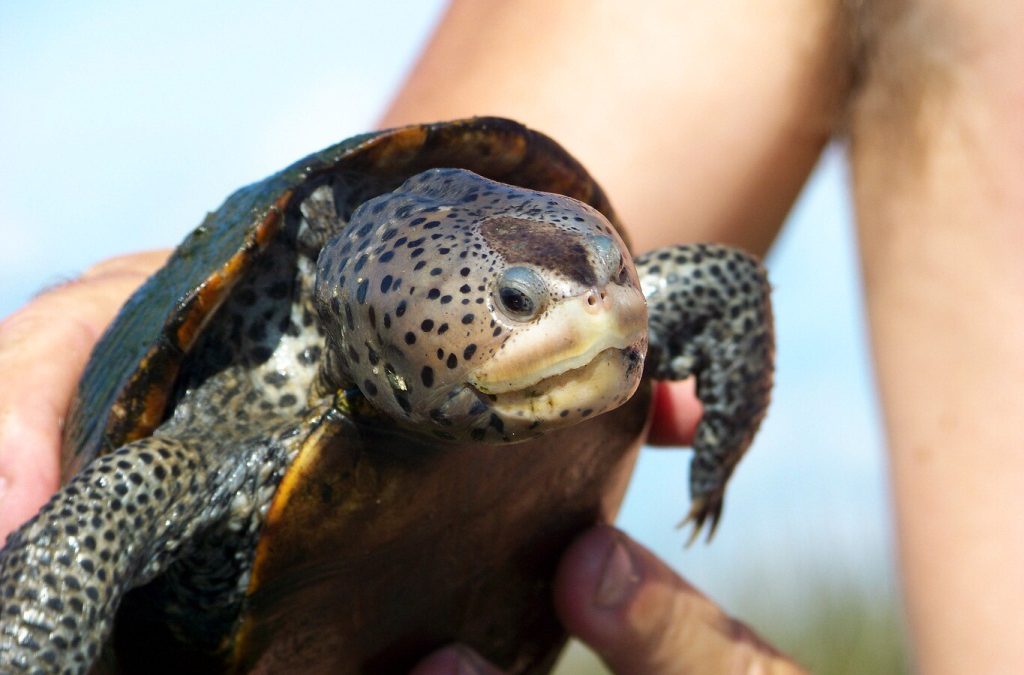
by Rick O'Connor | Mar 29, 2019
We have a lot of really cool and interesting creatures that live in our bay, but one many may not know about is a small turtle known as a diamondback terrapin. Terrapins are usually associated with the Chesapeake Bay area, but actually they are found along the entire eastern and Gulf coast of the United States. It is the only resident turtle of brackish-estuarine environments, and they are really cool looking.
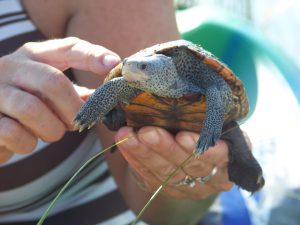
The diamond in the marsh. The diamondback terrapin.
Photo: Molly O’Connor
Terrapins are usually between five and 10 inches in length (this is the shell measurement) and have a grayish-white colored skin, as opposed to the dark green-black found on most small riverine turtles in Florida. The scutes (scales) of the shell are slightly raised and ridged to look like diamonds (hence their name). They are not migratory like sea turtles, but rather spend their entire lives in the marshes near where they were born. They meander around the shorelines and creeks of these habitats, sometimes venturing out into the seagrass beds, searching for shellfish – their favorite prey. Females do come up on beaches to lay their eggs but unlike sea turtles, they prefer to do this during daylight hours and usually close to high tide.
Most folks living here along the Gulf coast have not heard of this turtle, let alone seen one. They are very cryptic and difficult to find. Unlike sea turtles, we usually do not give them a second thought. However, they are one of the top predators in the marsh ecosystem and control plant grazing snails and small crabs. During the 19th century they were prized for their meat in the Chesapeake area. As commonly happens, we over harvested the animal and their numbers declined. As numbers declined the price went up and the popularity of the dish went down. There was an attempt to raise the turtles on farms here in the south for markets up north. One such farm was found at the lower end of Mobile Bay.
Early 20th century still found terrapin on some menus, but the popularity began to wane, and the farms slowly closed. Afterwards, the population terrapins began to rebound – that was until the development of the wire meshed crab trap. Developed for the commercial and recreational blue crab fishery, terrapins made a habitat of swimming into these traps, where they would drown. In the Chesapeake Bay area, the problem was so bad that excluder devices were developed and required on all crab traps. They are not required here in Florida, where the issue is not as bad, but we do have these excluders at the extension office if any crabber has been plagued with capturing terrapins. Studies conducted in New Jersey and Florida found these excluder devices were effective at keeping terrapins out of crab traps but did not affect the crab catch itself. Crabs can turn sideways and still enter the traps.
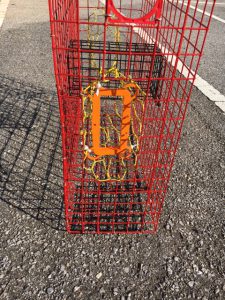
This orange plastic rectangle is a Bycatch Reduction Device (BRD) used to keep terrapins out of crab traps – but not crabs.
Photo: Rick O’Connor
Another 20th century issue has been nesting predation by raccoons. As we began to build roads and bridges to isolated marsh islands in our bays, we unknowingly provided a highway for these predators to reach the islands as well. On some islands, raccoons depredated 90% of the terrapin nests. Today, these turtles are protected in every state they inhabit except Florida. Though there is currently no protection for the terrapin itself in our state, they do fall under the general protection for all riverine turtles; you may only possess two at any time and may not possess their eggs.
Some scientists have discussed identifying terrapins as a sentinel species for the health of estuaries. Not having terrapin in the bay does not necessarily mean the bay is unhealthy, but the decline of this turtle (or the blue crab) could increase the population of smaller plant grazing invertebrates they eat throwing off the balance within the system.
Sea Grant trains local volunteers to survey for these creatures within our bay area. Trainings usually take place in April and surveys are conducted during May and June. This year we will be training volunteers in the Perdido area on April 10 at the Southwest Branch of the Pensacola Library on Gulf Beach Highway. That training will begin at 10:00 AM. For Pensacola Beach the training will be on April 15 at the Navarre Beach Sea Turtle Conservation Center on Navarre Beach. That training will begin at 9:00 AM. A third training will take place on April 22 at the Port St. Joe Sea Turtle Center in Port St. Joe. For more information on diamondback terrapins contact me at the Escambia County Extension Office – (850) 475-5230 ext. 111.
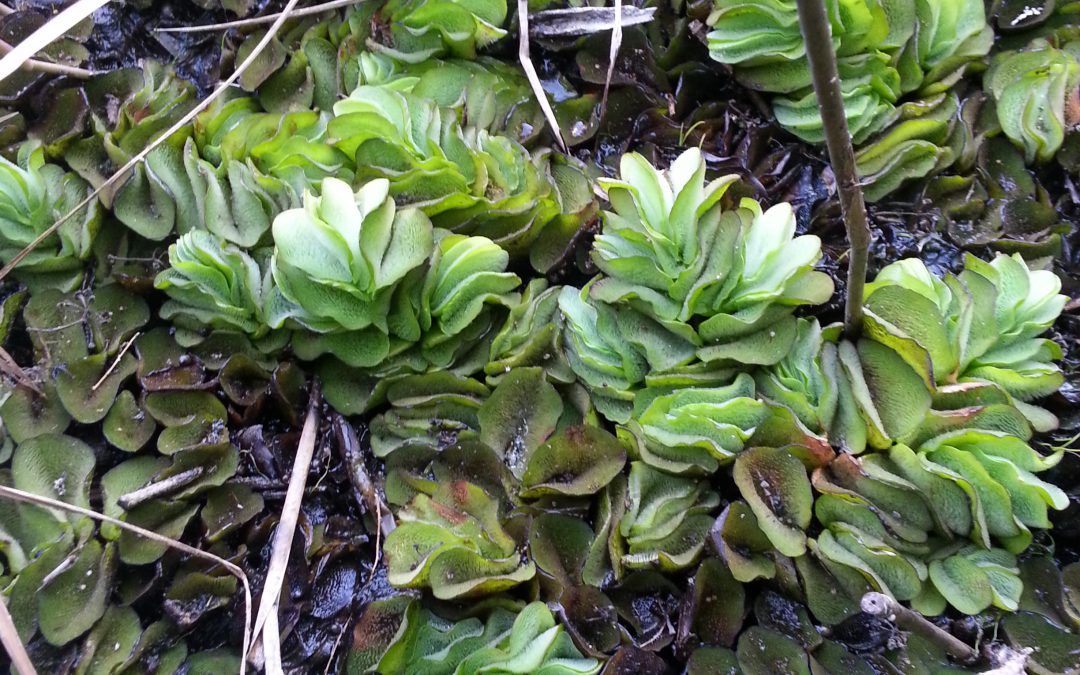
by Rick O'Connor | Mar 29, 2019
Giant Salvinia (Salvinia molesta) is an aggressively spreading free floating plant that can cover the surface of a water body reducing water flow, sunlight penetration, and dissolved oxygen to a point where the over health and biodiversity of the water body is compromised – we do not want it here.
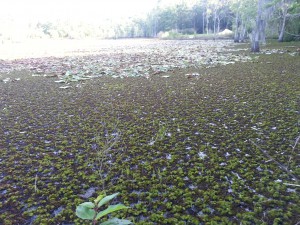
Giant Salvinia mats completely covering Bay County pond. This fast growing invasive can double in coverage every two weeks! Photo by L. Scott Jackson
The plant is originally from Brazil and was probably brought here for oriental ponds and aquariums. The plant is so aggressive and detrimental to waters it invades that in 2013 the International Union for the Conservation of Nature listed it as one of the world’s 100 worst invasive plants. Locally it is listed as a federal noxious weed and is prohibited in the state of Florida.
It has been found in Pensacola. We, along with Bay County, are the only two counties in the panhandle with the plant (that we know of). Something that is not so good. We would like to get rid of what we have and control the spread to other waterways and counties.
How do we do this?
Well, FWC has a team based out of Panama City that focuses on control and removals – they are on it. We know locally it has been found in the Jackson Lakes near Bayou Chico, and – even though it is a freshwater plant – has been found in the upper reaches of Bayou Chico itself. FWC is currently treating known locations but we need the help of shoreline residents controlling the plants that are in front of your property.
It is a floating plant, resembling duckweed but the leaves are larger (1-4” in length). The hairy looking roots hang in the water to gather nutrients. There bundles of small hair like structures on the surface of the curved leaves. Groups of four hairs rise vertically and touch at the tips (resembling an egg beater or wisp). They are very small, but with a magnifying glass you can see these. If found, you can use a hand-held crab net to dip them out of the water and place somewhere they can dry out and die. They spread quickly by fragmentation and spores. So be sure to collect all fragments of the plant.
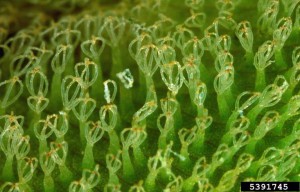
Photo by Barry Rice, sarracenia.com, Bugwood.org Rows of egg beater or light bulb shaped leaf hairs are a unique identifying characteristic of giant salvinia.
If you do find, please let us know here at the extension office so that we can report this to FWC.
You can also report the plant on https://www.eddmaps.org/.
You can learn more about this invasive plant at http://plants.ifas.ufl.edu/plant-directory/salvinia-molesta/.
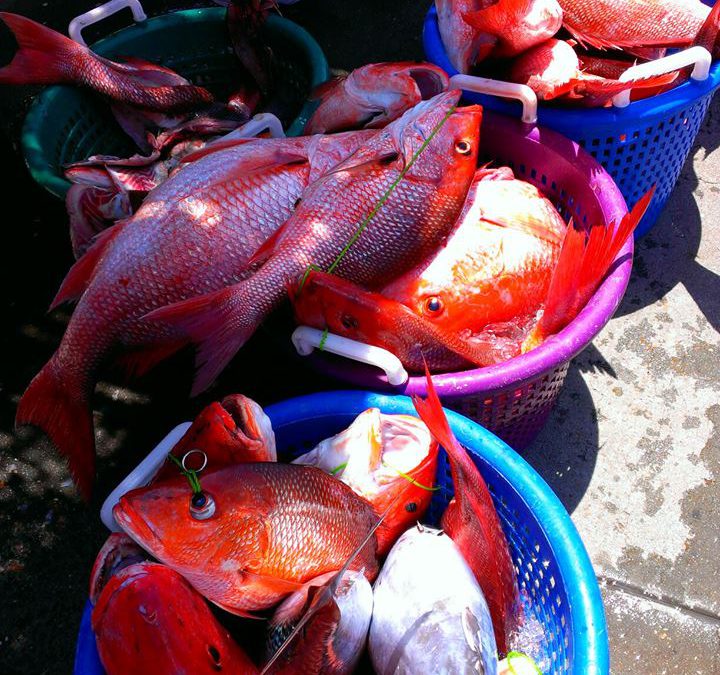
by Rick O'Connor | Mar 20, 2019
I recently had the fortunate opportunity to observe a commercial longline vessel being unloaded at a landing near Perdido Key. 10,000 pounds of fish, mostly grouper and tilefish, were being unloaded for markets in Atlanta, Canada, and locally. When I heard 10,000 pounds two things popped into my head right way…
1) That is a lot of fish
2) It is great to know that fresh local seafood can still be had.
It is a lot of fish, and this concerns some about the future of wild caught seafood. Humans have been harvesting wild caught seafood since the beginning of time, or at least as far back as boats go. What has changed today is better technology and more fishermen on the water. With these issues in mind, you have to either (a) reduce the number of fishermen on the sea, or (b) reduce the number of fish harvested. Though not always popular, this is where fisheries management comes in.
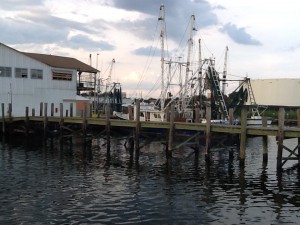
Commercial seafood is a large part of Florida’s economy and culture.
Photo: Rick O’Connor
The basic idea is to allow each species a chance to breed at least once before they are harvested. The Magnuson-Stevens Act, passed in 1996, requires that commercial fisheries within U.S. territorial waters be sustainable – meaning viable into perpetuity. To do this you need to know the life cycles of your target species. At what age do they become sexually mature and begin breeding? The age of a fish can be determined by rings in the otolith (ear bone) and there is a correlation between the number of rings and the length of the fish; hence the length regulations many species have. You need to know at what age they reach maturity, you allow one (sometimes more) years beyond this age allowing them to breed.
The next metric is how many of the mature adults can you allow to be harvested and remain sustainable. This obviously takes a lot of fisheries biology, and there are researchers at the federal, state, and university levels who work on these questions. When you know the answer to some of the biology questions, you can now input this into a computer model and determine what is known as the maximum sustainable yield, or how many fish (or the number of pounds) can be removed and still be sustainable.
Computer models are only as good as the programs that are developed for them. These can be hard to test. Hurricane computer models have become pretty good. Everyone remembers when Michael was approaching the Pensacola area and the modelers were sure it would make an eastward turn; and it eventually did. The thing about hurricane models is that if they are not working well, you know relatively quickly. Hurricane approaches shore – computer predicts where it will go – it makes landfall somewhere else – you correct the model – we get better. With fisheries, and other issues, we do not always get feedback as quickly as this. Stock assessments for selected species have to be made to see how the models are working, and this takes time.
Though it may not be an exact science, fisheries management certainly has helped hold on to some species that would have been harvested out otherwise.
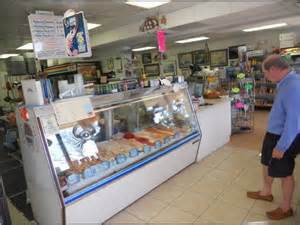
There are about 80 species of commercial seafood products that come from Florida.
Photo: Florida Sea Grant
As far as knowing local seafood is still available, this is good news for many. Checking in with your local seafood markets you can find a variety of species at different times of the year. Some provide information as to which local restaurants they sell to. Many locals, and visitors, are willing to pay a higher price for these sought-after seafood species. It is good to know you can still get them in our area.
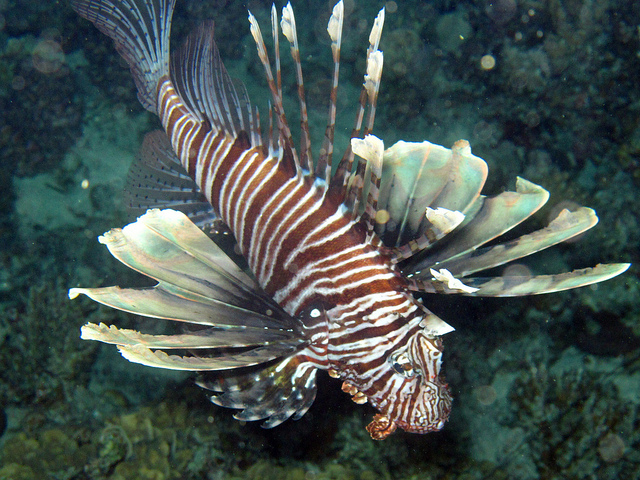
by Rick O'Connor | Mar 6, 2019
The vast majority of you reading this are aware of the lionfish, but for those who are not, this is a non-native invasive fish that has caused great concern within the economic and environmental communities. Lionfish were first reported in the waters off southeast Florida in the late 1980s. They dispersed north along the east coast of the state, over to Bermuda, throughout the Caribbean, and were first reported here in the northern Gulf of Mexico in 2010. It has been reported as the greatest invasion of an invasive species ever. In 2014, it was also reported that the highest densities of lionfish within the south Atlantic region were right here in the northern Gulf.
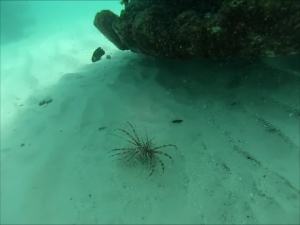
Lionfish at Pensacola Beach Snorkel Reef. Photo Credit: Robert Turpin
The creature is a voracious predator, consuming at least 70 species of small reef fish. For what ever reason, they prefer artificial reefs over natural ones and studies show that red snapper are further away, and higher above, artificial reefs that lionfish inhabit. All of this points to an economic and environmental problem with native fisheries in area waters.
So, what has been going on with lionfish in recent years?
What is the new science?
In 2018 Florida Fish and Wildlife Conservation Commission held its second statewide lionfish summit, and in 2019 Sea Grant held a panhandle regional lionfish workshop to get answers to these questions. There were sessions on recent research, impacts of the commercial harvest, and current regulations on harvesting the animals.
From the researchers we heard that the densities in the northern Gulf of Mexico have decreased over the last five years, at least in the shallow waters less than 120 feet. This is most probably due to the heavy harvest efforts from locals and from tournaments. They found that lionfish still prefer artificial over natural reefs but that their overall body condition on artificial reefs is poorer than those found on natural bottom. They have found evidence of some consumption of juvenile red snapper, but juvenile vermillion snapper have become a favorite. Another interesting discovery, they are feeding on other lionfish. Consumed lionfish are not as common as other species, but it is happening. They are also finding lionfish with ulcers on the skin. They are not sure of the cause, or whether this is impacting their population, but they will continue to study.
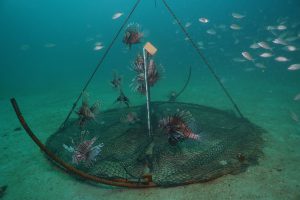
Deep water lionfish traps being tested by the University of Florida offshore Destin, FL. [ALEX FOGG/CONTRIBUTED PHOTO]
Can traps be found easily?
Will tethered buoys impact migrating species in the area?
Will the traps move between time of deployment and recovery?
How much by-catch will they harvest?
These are all concerns but there was some good news. Several different designs have been tried but one in particular, being studied by NOAA and the University of Florida, has had some success. The trap unfolds as hits the bottom, stays in the same location (even during recent storms), and only has about 10% by-catch – 90% of what it catches is lionfish. These traps are un-baited as well, using structure to attract them. However, these were not tethered to buoys (so there are questions there) and there is a larger issue… federal regulations.
Currently trapping for finfish in federal waters (9 miles out) is illegal in the Gulf of Mexico. Another issue is based on the Magnuson Act, all commercial harvest in federal waters needs to be sustainable. You cannot overharvest your target species, which is exactly what we want to do with lionfish. So, these regulatory hurdles will have to be dealt with before deep-water commercial harvest with traps could begin.
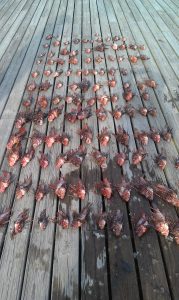
Harvested lionfish. Photo Credit: Bryan Clark
The current method of commercial harvest is with spearfishing SCUBA divers. The sale of salt water products license to do so soared between 2014 and 2016, but since there has been a declined. At the recent workshop the commercial harvesters and restaurants were there to discuss this problem.
First, the divers feel they need to be paid more in order to cover the cost of their harvest. This has become even harder in lieu of the decline in shallow, safe diving depth, waters. However, the restaurants feel the price needs to drop in order for them to offer the dish at a reasonable price to their customers. Most of the commercially harvested fish are currently going to markets outside the area where the current price is acceptable. The workshop suggested that this trend will probably continue and fewer harvesters will stay in the business. That said, the dive charters indicated they are making money taking charters out to specifically shoot lionfish for private consumption. This venture will probably increase.
So, after 10 years of lionfish in local waters, it appears that we have made a dent in their shallow water populations but must keep the pressure on. Several researchers indicated that frequent removals do make an impact, but infrequent does little – so the pressure needs to stay on. Deep water populations… we will have to see where the trap story goes.
If you have further questions on the current state of lionfish in our area, contact me at the Escambia County Extension Office. (850) 475-5230 ext. 111.
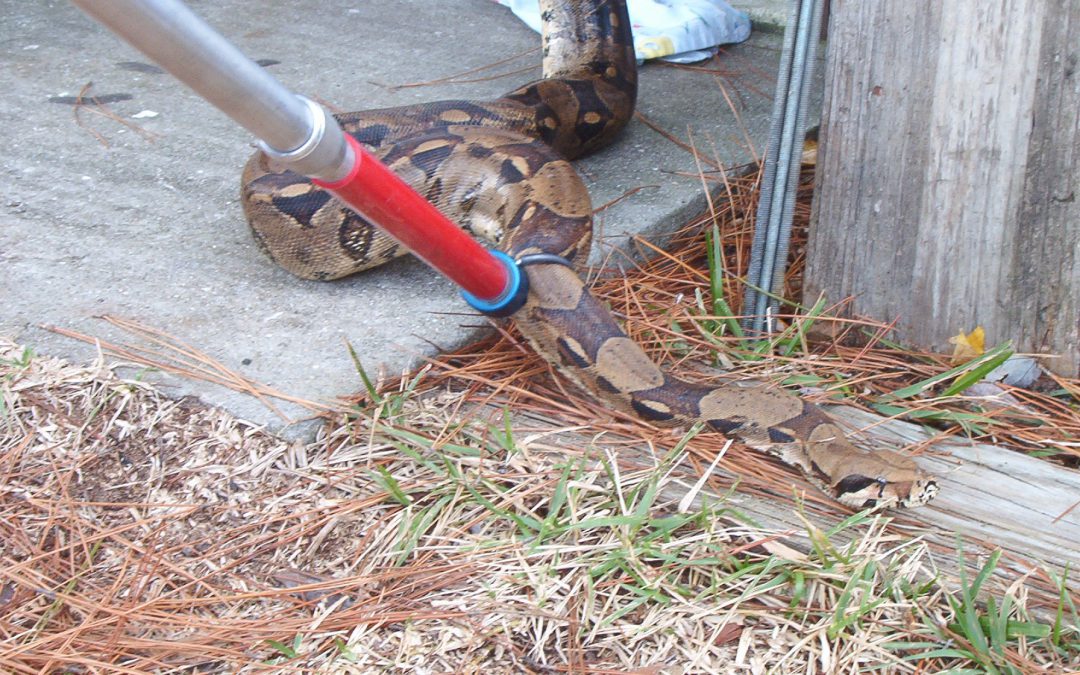
by Rick O'Connor | Mar 5, 2019
I am a pro and con guy.
When our family has a big decision to make, they usually ask me to list pros and cons before we make such a decision, it is something I have done since I can remember. It is not that different from the seven-year rule. When faced with a big decision, some native American cultures discuss how this decision will impact their families and the community seven years down the road.
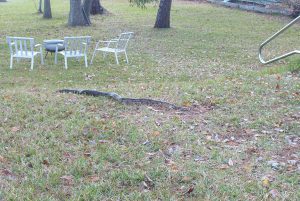
A large boa constrictor escaped in a neighborhood in Pensacola.
Photo Courtesy of Escambia County Animal Control
When I first saw the new Florida Fish and Wildlife Conservation Commission’s prohibited exotic species list, I thought of this pro-con / seven-year rule idea. For example, the Meerkat is on the list. A meerkat. Is this a good pet to start off with? Are they easy to maintain? To feed? Are they pets (as in… can you PET them)?
As I thought through my pro/con-seven-year idea, I thought not – but others obviously do. There are a lot of strange exotic pets in the United States and around the world. A species of turtle that I monitor is a pet trade target. The largest markets are China and the United States. I am guessing status is one reason why people chose pro over con. Maybe they do not think of the cons before making this decision, or maybe the pros are more important to them, so they are willing to overcome the cons – I am not sure.
Either way, FWC’s decision to prohibit this new list of species is not because they might make bad pets, rather it is their high risk of becoming invasive. Florida knows all too well how many of these exotic pets become problems in our local ecosystems. Lionfish, pythons, tegus to name a few. By definition, invasive species cause either environmental or economic problems for the communities where they become established – sometimes both. In 2014, the United States spent over 180 million dollars battling invasive species. We just completed our first statewide Weed Wrangle Event where volunteers went into the community and removed as many invasive plants as they could on a single day. The statewide numbers are not out yet, but locally the Six Rivers CISMA spent the morning removing Chinese Privet, Camphor trees, and Japanese Climbing Fern from a popular biking trail in a state park. And we all know, we will have to do it again.
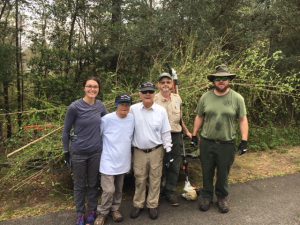
A group of volunteers from the Florida Park Service and Americorp helped to remove invasive plants during a recent Weed Wrangle event.
Photo: Rick O’Connor
Some say that spending time and money trying to control these invasive is a waste. Others know that not doing so could lead to a serious environmental or economic problem – so the weeds must be pulled, and the animals captured. All scientists and resource managers who deal with invasive species understand their best chance of eradicating them is when they FIRST appear on the scene – Early Detection, Rapid Response (EDRR). This is also the most cost-effective point in the invasion to work on them. However, most citizens do not know about certain invasive species until they are common in the landscape, and many times it is now too late for eradication – time to go into control mode.
One local species we hope we have begun working on soon enough to eradicate is Beach Vitex (Vitex rotundifolia). This plant is not that common statewide and is a potential target for eradication. Many along our barrier islands know of the plant now and, hopefully, will manage it on their property before it becomes widespread and problematic.
It was in this light that the FWC decided to approve a rule that would prohibit selected exotic animals as pets in Florida. These were considered high risk for becoming invasive if they were to escape or were released. This includes:
Mammals: Meerkats, Mongoose, Raccoon dogs, Dholes, Bushtail possums, and Flying foxes
Birds: Diochs, Red-whiskered Bul-Bul, Java sparrow, and Pink starling
Reptiles: Brown tree snake, Yellow anaconda, Beni anaconda, and Deschauensee’s anaconda
It is the hope that through this rule it will be harder to obtain these animals as pets and possible release into Florida’s landscapes. It is also a hope that people will reconsider having such creatures as pets in the first place. The pro-con / seven-year plan should be considered before buying any pet, particularly exotic ones.
To learn more about local invasive species and what you can do to help manage them on your property, you can visit the FWC page https://myfwc.com/wildlifehabitats/nonnatives/, or contact your county extension office.
















